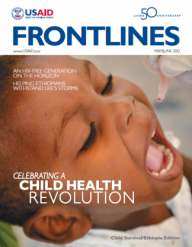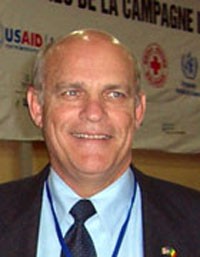 Senegal: Demonstrating the proper use of ITNs in Senegal.
Maggie Hallahan
Senegal: Demonstrating the proper use of ITNs in Senegal.
Maggie Hallahan
 Senegal: Demonstrating the proper use of ITNs in Senegal.
Maggie Hallahan
Senegal: Demonstrating the proper use of ITNs in Senegal.
Maggie Hallahan
I arrived in Afrancho—a farming community in Ghana’s Ashanti region—to the sounds of drumming and dancing. The morning sun shone down on the assembled crowd as we greeted the chiefs and queen mothers who were launching an insecticide-treated mosquito net (ITN) distribution and hang-up campaign. These local leaders, along with Ghana health services and NGO personnel, have proven to be instrumental in mobilizing and educating the community about the importance of sleeping under ITNs to prevent malaria.
Malaria is primarily a disease of rural areas, affecting those residents who live in poverty and have only limited access to quality health care. Malaria does not threaten boys and girls in the United States, but across Africa, the lives of could-be future presidents, scientists and nurses are lost prematurely, and their hope for making an impact on the world is greatly diminished.
Preventive interventions, such as ITNs, are lifesaving in countries like Ghana, where malaria is a leading cause of mortality, and one in 12 children do not reach their fifth birthday.
Net ownership does not necessarily equate with net usage. According to the latest nationwide survey in Ghana, about half of the children under 5 years old who have access to a net in their home do not sleep under it. Therefore, delivering ITNs is not enough: conducting follow-up educational activities to increase appropriate and consistent mosquito net use is also critical.
As I watched volunteers perform a drama about sleeping under mosquito nets, I was grateful for having slept under the protection of a bed net and having had access to medicine when I fell ill with malaria in Vietnam, where I lived as a child.
PMI Highlights
Highlights from PMI’s sixth annual report to Congress (April 2012) covering PMI’s 19 focus countries.
- More than 28 million people were protected as a result of PMI-supported indoor residual spraying in FY 2011.
- More than 59 million insecticide-treated mosquito nets have been procured and more than 31 million distributed since PMI began.
- More than 116 million lifesaving antimalarial treatments have been procured and more than 92 million distributed since PMI began.
- More than 42,000 health workers were trained on case management in FY 2011.
- More than 34,000 health workers were trained on malaria laboratory diagnosis in FY 2011.
- More than 28,000 health workers were trained on the prevention and treatment of malaria in pregnant women in FY 2011.
In the past six years, the U.S. Government and partners have reached millions of people in sub-Saharan Africa with ITNs, as well as other prevention and treatment interventions. By preventing children from contracting malaria, we are making them healthier and more productive over the long run, and unburdening the health system to free up resources to address other critical needs.
Investing in malaria control is particularly powerful because of its enormous burden, and because the impact of malaria prevention and treatment efforts is quickly and dramatically evident.
We know what causes malaria, we know how to prevent it, and we know how to treat it. By working with national governments to implement their malaria strategies; using available resources for effective prevention; and developing robust case-management programs to diagnose fevers, identify malaria and treat it with ACTs (artemisinin-based combination therapies), we can build upon the gains we’ve made in combatting malaria as a public health problem in Africa. We have seen tremendous success against malaria, thanks to an infusion of resources, innovation and political will. World Malaria Day 2012 is a reminder that ending malaria as a major killer of children is now considered possible and it is vitally important that we sustain our momentum toward that goal.
The Intolerable Burden
The President’s Malaria Initiative (PMI), led by USAID and implemented with the U.S. Centers for Disease Control and Prevention, is a major component of the U.S. Government’s Global Health Initiative (GHI), announced by President Barack Obama in May 2009. PMI was launched in June 2005 by former President George W. Bush to reduce the intolerable burden of malaria and help relieve poverty on the African continent.
Based on the 2008 Lantos-Hyde Act, PMI’s goal was broadened to achieve Africa-wide impact by halving the burden of malaria in 70 percent of at-risk populations in sub-Saharan Africa. That equates to approximately 450 million residents. PMI now includes 19 focus countries (Angola, Benin, Democratic Republic of Congo, Ethiopia, Ghana, Guinea, Kenya, Liberia, Madagascar, Malawi, Mali, Mozambique, Nigeria, Rwanda, Senegal, Tanzania, Uganda, Zambia and Zimbabwe) and a regional program in the Greater Mekong subregion.
PMI supports four primary interventions to prevent and treat malaria: indoor residual spraying with insecticides; insecticide-treated mosquito nets; intermittent preventive treatment for pregnant women; and diagnosis of malaria and treatment with artemisinin-based combination therapy.
Over the past five years, many African countries have reported substantial progress in reducing their burden of malaria. In 11 PMI-supported countries with baseline and follow-up nationwide household surveys (Angola, Ethiopia, Ghana, Kenya, Madagascar, Malawi, Rwanda, Senegal, Tanzania, Uganda and Zambia), substantial reductions in all-cause mortality (ranging from 16 percent to 50 percent) have been documented in children under age 5. PMI is evaluating the contribution of malaria-control efforts to these declines in mortality, but there are strong indications that a substantial portion of the decline is due to malaria control.










Comment
Make a general inquiry or suggest an improvement.